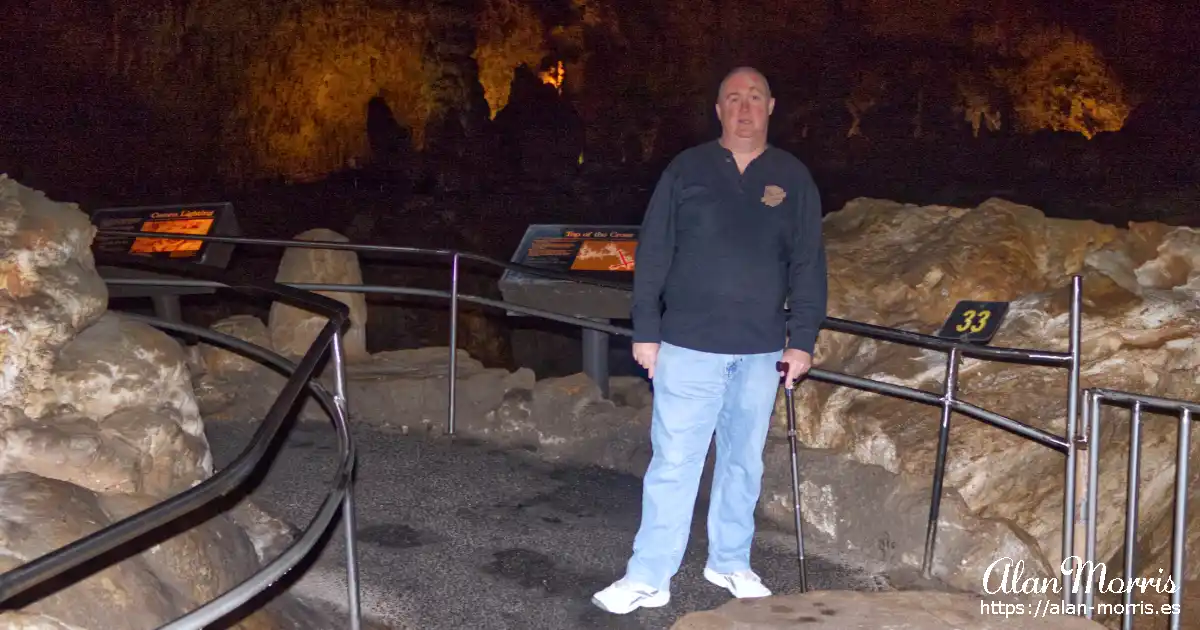We didn't have very long at Carlsbad Caverns, but I did manage to get to the bottom of the main cave and back up.
As hot as it was outside, it was very cold at the bottom of the caves. The different caves I went through had giant stalagmites, stalactites and other fantastic rock formations. How the people discovering the caves found their way out again is mind-boggling.
History.
While a young boy, Jim White explored the cavern with his homemade wire ladder, and he named many of the areas within the caves, including the Big Room, New Mexico Room, Kings Palace, Queens Chamber, Papoose Room and Green Lake Room. He also named many of the cave's more prominent formations, such as the Totem Pole, Witch's Finger, Giant Dome, Bottomless Pit, Fairyland, Iceberg Rock, Temple of the Sun, and Rock of Ages.
Until 1932, visitors to the cavern had to walk down a switchback ramp that took them 750 feet below the surface. The walk back up was tiring for many visitors, and in 1932, the National Park opened up a large visitor centre building with two elevators that would take visitors to the caverns below.
Named Areas within the Caves.
Many of the areas or formations have names, and the ones described below are just some of them.
Balloon Ballroom.
Located in the ceiling above the main entrance hall, this small room was first accessed by tying a rope to a bunch of balloons and floating them up into the passage.
Bat Cave.
A significant, unadorned rocky passage connected to the main entrance corridor. Most of the cave's bat population lives in this portion, which was mined for bat guano in the early 20th century.
Bell Cord Room.
It was named for a long, narrow stalactite coming through a hole in the ceiling, resembling the rope coming through the roof of a belfry. This room is located at the end of the Left-Hand Tunnel.
Bifrost Room.
Discovered in 1982, it is located in the ceiling above Lake of the Clouds. Its name refers to a Norse myth about a world in the sky that was accessed from Earth by a rainbow. The room was named because of its location above the Lake of the Clouds and its colourful oxide-stained formations.
Big Room or The Hall of the Giants.
The largest chamber in Carlsbad Caverns, with a floor space of 357,469 square feet (33,210 m2).
Chocolate High.
A maze of small passages totalling nearly a mile (1500 m) in combined length was discovered in 1993 above a mud-filled pit in the New Mexico Room known as Chocolate Drop.
Green Lake Room.
The uppermost of the "Scenic Rooms" is named for a deep, malachite-coloured pool in the corner of the room. In the 1940s, when the military was testing the feasibility of Carlsbad Caverns as an emergency fallout shelter, the Green Lake Room was used to look for ripples caused by a nuclear bomb test many miles away. None appeared.
Guadalupe Room.
Discovered by a park ranger in 1966, this is the second-largest room in Carlsbad Caverns. It is known for its dense collection of "soda straw" stalactites.
Hall of the White Giant.
A large chamber containing a large, white stalagmite. Rangers regularly lead special wild-cave tours to this room.
King's Palace.
The first of four chambers in a wing known as the "scenic rooms" is named for a large castle-like formation in the centre of the room.
Lake of the Clouds.
The lowest known point in the cave. It is located in a side passage off the Left-Hand Tunnel. It is named for its large lake containing globular, cloud-like rock formations formed underwater when the lake level was much higher.
Left-Hand Tunnel.
A long, straight passage marked by deep fissures in the floor. These fissures are not known to lead anywhere. The Left-Hand Tunnel leads to the Lake of the Clouds and the Bell Cord Room.
Mabel's Room.
A moderate-sized room located past the Talcum Passage in Lower Cave.
Mystery Room.
A large, sloping room off the Queen's Chamber was named for an unexplained noise heard only here. A small vertical passage at the far end connects it to Lower Cave.
New Mexico Room.
It is located adjacent to the Green Lake Room and accessed using a narrow corridor.
New Section.
A section of fissures east of the White Giant formation parallels the Bat Cave. Discoveries are still being made in this section.
Papoose Room.
It is located between the King's Palace and the Queen's Chamber.
Queen's Chamber.
It is widely regarded as the cave's most beautiful and scenic area. Jim White's lantern went out in this chamber while he was exploring, and he was in the dark for over half an hour.
Spirit World.
Located in the ceiling of the Big Room at its highest point (an area known as the Top of the Cross), this area is filled with white stalagmites that resemble angels.
Talcum Passage.
A room located in Lower Cave where the floor is coated with gypsum dust.
The Rookery.
One of the larger rooms in Lower Cave. A large number of cave pearls are found in this area.
Underground Lunchroom.
It is in the Big Room at the head of the Left-Hand Tunnel. It contains a cafeteria built in the 1950s and is where the elevators from the visitor centre exit into the cave.
